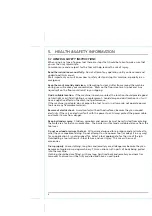
14
9.1 PRELIMINARY OPERATIONS
– Completely deflate the tyre.
WARNING: If tyre pressure monitoring sensors (TPMS) are fitted to the tyre, the pressure
must be released slowly. Sudden loss of pressure may damage the sensors. Always check
with the vehicle manufacturer before deflating tyre.
– Remove wheel balancing weights to avoid any interference with the clamping
mechanism.
9.2 BEAD BREAKING (FIG.7).
WARNING: Tyre MUST be deflated before bead
breaking.
– Place the wheel on the ground near the bead
breaker, move the plate
to the bead and press
the bead breaking control pedal
.
– This operation is repeated at various points on the
wheel until the bead is completely detached.
– Repeat the operation on the opposite side of the
wheel.
WARNING:
When using the bead breaking arm,
take care not trap limbs between the tyre and the
bead breaker.
9.3 UNMOUNTING (FIGS.7, 8 – 9).
– Lower the locking lever
to unlock the vertical
rod
.
– Press the open/close control pedal
to prepare
the locking wedges
to lock the rim externally
(in the case of internal locking, this operation is
not carried out).
– Place the wheel on the self-centring turntable
, pressing lightly on the wheel. Press the
open/close control pedal
to lock it.
– Lubricate the bead with specialist tyre lubricant.
– Move the head
close to the rim so that the
roller
and the rim edge surface touch.
– Raise locking lever
: in this way the vertical
spacing of the head and locking of the vertical rod;
the spacing of the head and locking of the arm;
the spacing of the tongue is adjusted by acting on
the handwheel
(3 mm ideal distance:).
– Raise the bead with the tyre lever and hook it onto
the tongue of the head
.
9. OPERATION AND USE
FIG.7
FIG.8

























